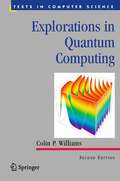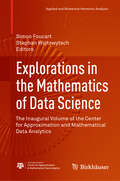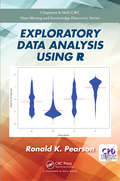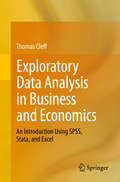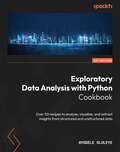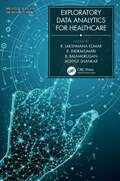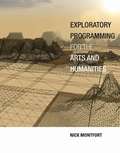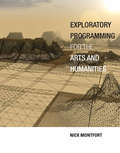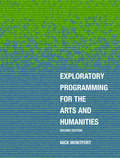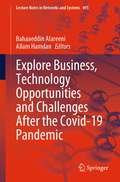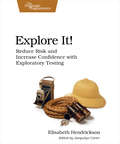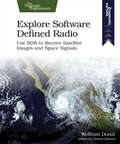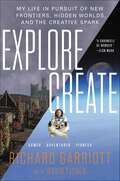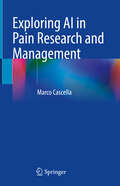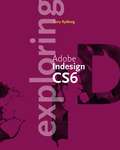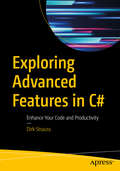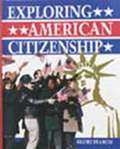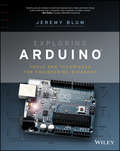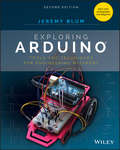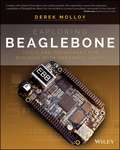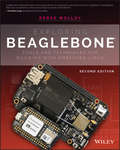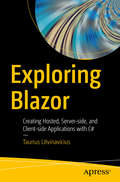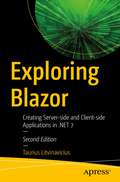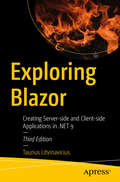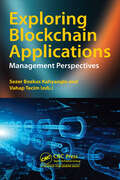- Table View
- List View
Explorations in Quantum Computing
by Colin P. WilliamsBy the year 2020, the basic memory components of a computer will be the size of individual atoms. At such scales, the current theory of computation will become invalid. "Quantum computing" is reinventing the foundations of computer science and information theory in a way that is consistent with quantum physics - the most accurate model of reality currently known. Remarkably, this theory predicts that quantum computers can perform certain tasks breathtakingly faster than classical computers - and, better yet, can accomplish mind-boggling feats such as teleporting information, breaking supposedly "unbreakable" codes, generating true random numbers, and communicating with messages that betray the presence of eavesdropping. This widely anticipated second edition of Explorations in Quantum Computing explains these burgeoning developments in simple terms, and describes the key technological hurdles that must be overcome to make quantum computers a reality. This easy-to-read, time-tested, and comprehensive textbook provides a fresh perspective on the capabilities of quantum computers, and supplies readers with the tools necessary to make their own foray into this exciting field. Topics and features: concludes each chapter with exercises and a summary of the material covered; provides an introduction to the basic mathematical formalism of quantum computing, and the quantum effects that can be harnessed for non-classical computation; discusses the concepts of quantum gates, entangling power, quantum circuits, quantum Fourier, wavelet, and cosine transforms, and quantum universality, computability, and complexity; examines the potential applications of quantum computers in areas such as search, code-breaking, solving NP-Complete problems, quantum simulation, quantum chemistry, and mathematics; investigates the uses of quantum information, including quantum teleportation, superdense coding, quantum data compression, quantum cloning, quantum negation, and quantum cryptography; reviews the advancements made towards practical quantum computers, covering developments in quantum error correction and avoidance, and alternative models of quantum computation. This text/reference is ideal for anyone wishing to learn more about this incredible, perhaps "ultimate," computer revolution. Dr. Colin P. Williams is Program Manager for Advanced Computing Paradigms at the NASA Jet Propulsion Laboratory, California Institute of Technology, and CEO of Xtreme Energetics, Inc. an advanced solar energy company. Dr. Williams has taught quantum computing and quantum information theory as an acting Associate Professor of Computer Science at Stanford University. He has spent over a decade inspiring and leading high technology teams and building business relationships with and Silicon Valley companies. Today his interests include terrestrial and Space-based power generation, quantum computing, cognitive computing, computational material design, visualization, artificial intelligence, evolutionary computing, and remote olfaction. He was formerly a Research Scientist at Xerox PARC and a Research Assistant to Prof. Stephen W. Hawking, Cambridge University.
Explorations in the Mathematics of Data Science: The Inaugural Volume of the Center for Approximation and Mathematical Data Analytics (Applied and Numerical Harmonic Analysis)
by Simon Foucart Stephan WojtowytschThis edited volume reports on the recent activities of the new Center for Approximation and Mathematical Data Analytics (CAMDA) at Texas A&M University. Chapters are based on talks from CAMDA’s inaugural conference – held in May 2023 – and its seminar series, as well as work performed by members of the Center. They showcase the interdisciplinary nature of data science, emphasizing its mathematical and theoretical foundations, especially those rooted in approximation theory.
Exploratory Data Analysis Using R (Chapman and Hall/CRC Data Mining and Knowledge Discovery Series)
by Ronald K. PearsonExploratory Data Analysis Using R provides a classroom-tested introduction to exploratory data analysis (EDA) and introduces the range of "interesting" – good, bad, and ugly – features that can be found in data, and why it is important to find them. It also introduces the mechanics of using R to explore and explain data. The book begins with a detailed overview of data, exploratory analysis, and R, as well as graphics in R. It then explores working with external data, linear regression models, and crafting data stories. The second part of the book focuses on developing R programs, including good programming practices and examples, working with text data, and general predictive models. The book ends with a chapter on "keeping it all together" that includes managing the R installation, managing files, documenting, and an introduction to reproducible computing. The book is designed for both advanced undergraduate, entry-level graduate students, and working professionals with little to no prior exposure to data analysis, modeling, statistics, or programming. it keeps the treatment relatively non-mathematical, even though data analysis is an inherently mathematical subject. Exercises are included at the end of most chapters, and an instructor's solution manual is available.
Exploratory Data Analysis in Business and Economics
by Thomas CleffIn a world in which we are constantly surrounded by data, figures, and statistics, it is imperative to understand and to be able to use quantitative methods. Statistical models and methods are among the most important tools in economic analysis, decision-making and business planning. This textbook, "Exploratory Data Analysis in Business and Economics", aims to familiarise students of economics and business as well as practitioners in firms with the basic principles, techniques, and applications of descriptive statistics and data analysis. Drawing on practical examples from business settings, it demonstrates the basic descriptive methods of univariate and bivariate analysis. The textbook covers a range of subject matter, from data collection and scaling to the presentation and univariate analysis of quantitative data, and also includes analytic procedures for assessing bivariate relationships. It does not confine itself to presenting descriptive statistics, but also addresses the use of computer programmes such as Excel, SPSS, and STATA, thus treating all of the topics typically covered in a university course on descriptive statistics. The German edition of this textbook is one of the "bestsellers" on the German market for literature in statistics.
Exploratory Data Analysis with Python Cookbook: Over 50 recipes to analyze, visualize, and extract insights from structured and unstructured data
by Ayodele OluleyeExtract valuable insights from data by leveraging various analysis and visualization techniques with this comprehensive guide Purchase of the print or Kindle book includes a free PDF eBookKey FeaturesGain practical experience in conducting EDA on a single variable of interest in PythonLearn the different techniques for analyzing and exploring tabular, time series, and textual data in PythonGet well versed in data visualization using leading Python libraries like Matplotlib and seabornBook DescriptionIn today's data-centric world, the ability to extract meaningful insights from vast amounts of data has become a valuable skill across industries. Exploratory Data Analysis (EDA) lies at the heart of this process, enabling us to comprehend, visualize, and derive valuable insights from various forms of data. This book is a comprehensive guide to Exploratory Data Analysis using the Python programming language. It provides practical steps needed to effectively explore, analyze, and visualize structured and unstructured data. It offers hands-on guidance and code for concepts such as generating summary statistics, analyzing single and multiple variables, visualizing data, analyzing text data, handling outliers, handling missing values and automating the EDA process. It is suited for data scientists, data analysts, researchers or curious learners looking to gain essential knowledge and practical steps for analyzing vast amounts of data to uncover insights. Python is an open-source general purpose programming language which is used widely for data science and data analysis given its simplicity and versatility. It offers several libraries which can be used to clean, analyze, and visualize data. In this book, we will explore popular Python libraries such as Pandas, Matplotlib, and Seaborn and provide workable code for analyzing data in Python using these libraries. By the end of this book, you will have gained comprehensive knowledge about EDA and mastered the powerful set of EDA techniques and tools required for analyzing both structured and unstructured data to derive valuable insights.What you will learnPerform EDA with leading python data visualization librariesExecute univariate, bivariate and multivariate analysis on tabular dataUncover patterns and relationships within time series dataIdentify hidden patterns within textual dataLearn different techniques to prepare data for analysisOvercome challenge of outliers and missing values during data analysisLeverage automated EDA for fast and efficient analysisWho this book is forWhether you are a data analyst, data scientist, researcher or a curious learner looking to analyze structured and unstructured data, this book will appeal to you. It aims to empower you with essential knowledge and practical skills for analyzing and visualizing data to uncover insights. It covers several EDA concepts and provides hands-on instructions on how these can be applied using various Python libraries. Familiarity with basic statistical concepts and foundational knowledge of python programming will help you understand the content better and maximize your learning experience.
Exploratory Data Analytics for Healthcare (Innovations in Big Data and Machine Learning)
by R. Lakshmana KumarExploratory data analysis helps to recognize natural patterns hidden in the data. This book describes the tools for hypothesis generation by visualizing data through graphical representation and provides insight into advanced analytics concepts in an easy way. The book addresses the complete data visualization technologies workflow, explores basic and high-level concepts of computer science and engineering in medical science, and provides an overview of the clinical scientific research areas that enables smart diagnosis equipment. It will discuss techniques and tools used to explore large volumes of medical data and offers case studies that focus on the innovative technological upgradation and challenges faced today. The primary audience for the book includes specialists, researchers, graduates, designers, experts, physicians, and engineers who are doing research in this domain.
Exploratory Programming for the Arts and Humanities
by Nick MontfortThis book introduces programming to readers with a background in the arts and humanities; there are no prerequisites, and no knowledge of computation is assumed. In it, Nick Montfort reveals programming to be not merely a technical exercise within given constraints but a tool for sketching, brainstorming, and inquiring about important topics. He emphasizes programming's exploratory potential -- its facility to create new kinds of artworks and to probe data for new ideas. The book is designed to be read alongside the computer, allowing readers to program while making their way through the chapters. It offers practical exercises in writing and modifying code, beginning on a small scale and increasing in substance. In some cases, a specification is given for a program, but the core activities are a series of "free projects," intentionally underspecified exercises that leave room for readers to determine their own direction and write different sorts of programs. Throughout the book, Montfort also considers how computation and programming are culturally situated -- how programming relates to the methods and questions of the arts and humanities. The book uses Python and Processing, both of which are free software, as the primary programming languages.
Exploratory Programming for the Arts and Humanities
by Nick MontfortA book for anyone who wants to learn programming to explore and create, with exercises and projects to help the reader learn by doing.This book introduces programming to readers with a background in the arts and humanities; there are no prerequisites, and no knowledge of computation is assumed. In it, Nick Montfort reveals programming to be not merely a technical exercise within given constraints but a tool for sketching, brainstorming, and inquiring about important topics. He emphasizes programming's exploratory potential—its facility to create new kinds of artworks and to probe data for new ideas. The book is designed to be read alongside the computer, allowing readers to program while making their way through the chapters. It offers practical exercises in writing and modifying code, beginning on a small scale and increasing in substance. In some cases, a specification is given for a program, but the core activities are a series of “free projects,” intentionally underspecified exercises that leave room for readers to determine their own direction and write different sorts of programs. Throughout the book, Montfort also considers how computation and programming are culturally situated—how programming relates to the methods and questions of the arts and humanities. The book uses Python and Processing, both of which are free software, as the primary programming languages.
Exploratory Programming for the Arts and Humanities, second edition
by Nick MontfortA new edition of a book for anyone who wants to learn programming to explore and create, with exercises and projects to help readers learn by doing.This book introduces programming to readers involved with the arts and humanities; there are no prerequisites, and no previous knowledge of programming is assumed. Nick Montfort reveals programming to be not merely a technical exercise within given constraints but a tool for sketching, brainstorming, and inquiry. He emphasizes programming's exploratory potential--its facility to create new kinds of artworks and to probe data for new ideas. The book is designed to be read alongside the computer, allowing readers to program while making their way through the chapters. It offers practical exercises in writing and modifying code and outlines "free projects" that allow learners to pursue their own interests.
Explore Business, Technology Opportunities and Challenges After the Covid-19 Pandemic (Lecture Notes in Networks and Systems #495)
by Allam Hamdan Bahaaeddin AlareeniThis book constitutes the refereed proceedings of the International Conference on Business and Technology (ICBT2021) organized by EuroMid Academy of Business and Technology (EMABT), held in Istanbul, between November 06–07, 2021. In response to the call for papers for ICBT2021, 485 papers were submitted for presentation and inclusion in the proceedings of the conference. After a careful blind refereeing process, 292 papers were selected for inclusion in the conference proceedings from forty countries. Each of these chapters was evaluated through an editorial board, and each chapter was passed through a double-blind peer-review process. The book highlights a range of topics in the fields of technology, entrepreneurship, business administration, accounting, and economics that can contribute to business development in countries, such as learning machines, artificial intelligence, big data, deep learning, game-based learning, management information system, accounting information system, knowledge management, entrepreneurship and social enterprise, corporate social responsibility and sustainability, business policy and strategic management, international management and organizations, organizational behavior and HRM, operations management and logistics research, controversial issues in management and organizations, turnaround, corporate entrepreneurship, and innovation, legal issues, business ethics, and firm governance, managerial accounting and firm financial affairs, non-traditional research and creative methodologies. These proceedings are reflecting quality research contributing theoretical and practical implications, for those who are wise to apply the technology within any business sector. It is our hope that the contribution of this book proceedings will be of the academic level which even decision-makers in the various economic and executive-level will get to appreciate.
Explore It!: Reduce Risk and Increase Confidence with Exploratory Testing
by Elisabeth HendricksonUncover surprises, risks, and potentially serious bugs with exploratory testing. Rather than designing all tests in advance, explorers design and execute small, rapid experiments, using what they learned from the last little experiment to inform the next. Learn essential skills of a master explorer, including how to analyze software to discover key points of vulnerability, how to design experiments on the fly, how to hone your observation skills, and how to focus your efforts.Software is full of surprises. No matter how careful or skilled you are, when you create software it can behave differently than you intended. Exploratory testing mitigates those risks. Part 1 introduces the core, essential skills of a master explorer. You'll learn to craft charters to guide your exploration, to observe what's really happening (hint: it's harder than it sounds), to identify interesting variations, and to determine what expected behavior should be when exercising software in unexpected ways. Part 2 builds on that foundation. You'll learn how to explore by varying interactions, sequences, data, timing, and configurations. Along the way you'll see how to incorporate analysis techniques like state modeling, data modeling, and defining context diagrams into your explorer's arsenal. Part 3 brings the techniques back into the context of a software project. You'll apply the skills and techniques in a variety of contexts and integrate exploration into the development cycle from the very beginning.You can apply the techniques in this book to any kind of software. Whether you work on embedded systems, Web applications, desktop applications, APIs, or something else, you'll find this book contains a wealth of concrete and practical advice about exploring your software to discover its capabilities, limitations, and risks.
Explore Software Defined Radio: Use Sdr To Receive Satellite Images And Space Signals
by Wolfram DonatDo you want to be able to receive satellite images using nothing but your computer, an old TV antenna, and a $20 USB stick? Now you can. At last, the technology exists to turn your computer into a super radio receiver, capable of tuning in to FM, shortwave, amateur "ham," and even satellite frequencies, around the world and above it. Listen to police, fire, and aircraft signals, both in the clear and encoded. And with the book's advanced antenna design, there's no limit to the signals you can receive. Combine your desktop or laptop computer with easy-to-find, Software Defined Radio (SDR) equipment, and tune in a wide range of signals in no time at all. Then, go one step further by converting a Raspberry Pi into your own dedicated SDR device. SDR USB dongles are usually designed to receive and decode high-definition digital television broadcasts, but the rising popularity of SDR has led to several of these devices being specifically made for - and marketed to - the software radio crowd. With step-by-step instructions, you'll have no problem getting everything up and running on both Windows and Linux. The antenna is the final piece in the SDR puzzle: Which antenna do you use? What shape do you need? How big does it have to be? And where do you point it? Get all the answers you need and learn what's possible when it comes to picking out or building an antenna. And if you're not particularly handy, don't worry. You can use an old-school set of rabbit ear antennas without too much modification. Discover the fun of this growing hobby and then open your ears to the hidden signals that surround you. What You Need: You will need a relatively recent computer or laptop, running either Windows or Ubuntu Linux. You can also use a Raspberry Pi. All of the software necessary is free and open-source, and the book describes in detail where to get it and how to install it, depending on your operating system.
Explore/Create: My Life in Pursuit of New Frontiers, Hidden Worlds, and the Creative Spark
by David Fisher Richard GarriottAn inventor, adventurer, entrepreneur, collector, and entertainer, and son of legendary scientist-astronaut Owen Garriott, Richard Garriott de Cayeux has been behind some of the most exciting undertakings of our time. A legendary pioneer of the online gaming industry—and a member of every gaming Hall of Fame—Garriott invented the multi-player online game, and coined the term “Avatar” to describe an individual’s online character.A lifelong adventurer and member of the Explorers Club, Garriott has used the fortune he amassed from the gaming business to embark on a number of thrilling expeditions. He has plumbed the depths of the Atlantic ocean to see the remains of the Titanic, hunted for meteorites in Antarctica, and in 2008 became one of the first private citizens to be launched into space. Richard has been one of the foremost pioneers of the private space industry, investing his time and energy into making space travel more accessible.In this fascinating memoir, Garriott invites readers on the great adventure that is his life. Yet his is no ordinary autobiography; throughout, Garriott engages readers with interactive activities and challenges them with “secret codes” for his games. An audacious genius with an insatiable curiosity and an irrepressible playfulness, Garriott takes readers on an unforgettable intellectual experience that is enlightening, adventurous, and fun.
Exploring AI in Pain Research and Management
by Marco CascellaThe book presents a unique and structured interdisciplinary approach, integrating insights from medicine, computer science, bioengineering, and other relevant fields. Due to this distinctive feature, the book offers a comprehensive exploration of the intricate relationship between potential AI applications and pain research and management. For example, one of its key aims is to provide valuable knowledge about AI for clinicians who may have limited familiarity with the subject, as well as for professionals in computer science and engineering. This approach is aimed at bridging the existing gap between these fields, offering clinicians insights into AI's potential applications, and providing computer scientists and engineers with a translational perspective on the practical needs in the clinical context. As widely demonstrated, the practical application of research faces a serious obstacle related to the limited communication and collaboration between research areas that are often very distant from each other. Therefore, this dual perspective could be useful to collocate the book as a valuable tool for fostering collaboration and understanding between these traditionally distinct domains. Furthermore, the structured framework of the book could not only facilitate learning but also serve as a foundation for future projects in the realm of AI and medicine. Specifically, it will be developed by following a framework useful for additional editorial projects, focusing more acutely on AI applications in anesthesia and critical care. By doing so, the book aims to contribute to the ongoing discourse and advancements in these specialized areas, filling a gap in the current literature. Therefore, the book seeks to make a meaningful contribution to the integration of AI in pain medicine, but also in other medical fields.
Exploring Adobe InDesign CS6
by Terry RydbergWith many software guides serving as high-tech "recipe books," teaching cookie-cutter habits with little relevance to complex, real-world projects, EXPLORING ADOBE INDESIGN CS6 takes a different approach. Emphasizing on fundamental design principles, critical thinking skills, and practical applications to prepare you for professional success, this unique text features step-by-step tutorials, vibrant illustrations, and realistic exercises to engage your interest while helping you develop essential software skills. Each chapter builds on what you have learned, guiding you from exploring basic operations to creating complex documents with confidence and efficiency. In addition to mastering InDesign CS6--including standard functionality and features new to this release--the text prepares you to analyze new design projects, identify potential challenges, develop effective strategies, and apply industry-standard principles and practices to execute your plans successfully. The Data Files used to complete the projects found in the book are now available online. For access information please refer to the directions available in the preface of the book.
Exploring Advanced Features in C#: Enhance Your Code and Productivity
by Dirk StraussBecome a more productive programmer by leveraging the newest features available to you in C#. This book highlights the new language features available to you and how to use these and other tools such as Bootstrap, SCSS, and jQuery to enhance your web applications.Exploring Advanced Features in C# starts with some of the new features of C# 7 such as how to implement local functions, tuples and generalized async return types. The book also looks at C# 8, where the author demonstrates how to implement nullable reference types, recursive patterns, ranges, indicies, switch expressions, and many more. Next, you go through some of the distinct features of C# that might often be overlooked such as generics, asynchronous programming, and dynamic types. The author demonstrates how to implement these features through clear and concise examples. Next, you’ll discuss creating responsive web applications using ASP.NET Model View Controller (MVC) where you’ll learn how to combine Bootstrap with jQuery and SCSS to create interactive web applications with a great-looking, user-friendly UI. Moving forward, you will create and run applications on the latest .NET Core version 3.0 as well as explore some of the features of .NET Core 3.0. Finally, you will go through the tips and tricks of Visual Studio 2019 that make you more productive.After reading the book, you will be able to implement new features available in C# and learn how to enhance your application development using ASP.NET MVC and .NET Core.What You Will LearnImplement the new features available in C# 7Enhance your web applications using ASP.NET MVC, Bootstrap, SCSS, and jQuery See what C# 8 has to offer with clear code examples Create and run applications in .NET Core 3.0Who This Is Book ForC# programmers who have worked with C# for a number of years and who want to keep up to date with the latest advancements of the language .
Exploring American Citizenship
by Globe FearonThe Student Texts and Student Workbooks provide helpful charts, tables, and maps that allow students to look closely at all critical aspects of U.S. government, including citizenship, the justice system, foreign policy, and much more. The book helps students understand the development of the government and the rights and laws of local, state, and federal governments.
Exploring Arduino
by Jeremy BlumLearn to easily build gadgets, gizmos, robots, and more using ArduinoWritten by Arduino expert Jeremy Blum, this unique book uses the popular Arduino microcontroller platform as an instrument to teach you about topics in electrical engineering, programming, and human-computer interaction. Whether you're a budding hobbyist or an engineer, you'll benefit from the perfectly paced lessons that walk you through useful, artistic, and educational exercises that gradually get more advanced. In addition to specific projects, the book shares best practices in programming and design that you can apply to your own projects. Code snippets and schematics will serve as a useful reference for future projects even after you've mastered all the topics in the book.Includes a number of projects that utilize different capabilities of the Arduino, while interfacing with external hardwareFeatures chapters that build upon each other, tying in concepts from previous chapters to illustrate new onesIncludes aspects that are accompanied by video tutorials and other multimedia content Covers electrical engineering and programming concepts, interfacing with the world through analog and digital sensors, communicating with a computer and other devices, and internet connectivityExplains how to combine smaller topics into more complex projectsShares downloadable materials and source code for everything covered in the bookProjects compatible with many official Arduino boards including Arduino Uno; Arduino Leonardo; Arduino Mega 2560; Arduino Due; Arduino Nano; Arduino Mega ADK; LilyPad Arduino and may work with Arduino-compatible boards such as Freeduino and new third party certified boards such as the Intel GalileoExploring Arduino takes you on an adventure and provides you with exclusive access to materials not found anywhere else!
Exploring Arduino: Tools and Techniques for Engineering Wizardry
by Jeremy BlumThe bestselling beginner Arduino guide, updated with new projects! Exploring Arduino makes electrical engineering and embedded software accessible. Learn step by step everything you need to know about electrical engineering, programming, and human-computer interaction through a series of increasingly complex projects. Arduino guru Jeremy Blum walks you through each build, providing code snippets and schematics that will remain useful for future projects. Projects are accompanied by downloadable source code, tips and tricks, and video tutorials to help you master Arduino. You'll gain the skills you need to develop your own microcontroller projects! This new 2nd edition has been updated to cover the rapidly-expanding Arduino ecosystem, and includes new full-color graphics for easier reference. Servo motors and stepper motors are covered in richer detail, and you'll find more excerpts about technical details behind the topics covered in the book. Wireless connectivity and the Internet-of-Things are now more prominently featured in the advanced projects to reflect Arduino's growing capabilities. You'll learn how Arduino compares to its competition, and how to determine which board is right for your project. If you're ready to start creating, this book is your ultimate guide! Get up to date on the evolving Arduino hardware, software, and capabilities Build projects that interface with other devices—wirelessly! Learn the basics of electrical engineering and programming Access downloadable materials and source code for every project Whether you're a first-timer just starting out in electronics, or a pro looking to mock-up more complex builds, Arduino is a fantastic tool for building a variety of devices. This book offers a comprehensive tour of the hardware itself, plus in-depth introduction to the various peripherals, tools, and techniques used to turn your little Arduino device into something useful, artistic, and educational. Exploring Arduino is your roadmap to adventure—start your journey today!
Exploring BeagleBone
by Derek MolloyIn-depth instruction and practical techniques for building with the BeagleBone embedded Linux platformExploring BeagleBone is a hands-on guide to bringing gadgets, gizmos, and robots to life using the popular BeagleBone embedded Linux platform. Comprehensive content and deep detail provide more than just a BeagleBone instruction manual--you'll also learn the underlying engineering techniques that will allow you to create your own projects. The book begins with a foundational primer on essential skills, and then gradually moves into communication, control, and advanced applications using C/C++, allowing you to learn at your own pace. In addition, the book's companion website features instructional videos, source code, discussion forums, and more, to ensure that you have everything you need.The BeagleBone's small size, high performance, low cost, and extreme adaptability have made it a favorite development platform, and the Linux software base allows for complex yet flexible functionality. The BeagleBone has applications in smart buildings, robot control, environmental sensing, to name a few; and, expansion boards and peripherals dramatically increase the possibilities. Exploring BeagleBone provides a reader-friendly guide to the device, including a crash course in computer engineering. While following step by step, you can:Get up to speed on embedded Linux, electronics, and programmingMaster interfacing electronic circuits, buses and modules, with practical examplesExplore the Internet-connected BeagleBone and the BeagleBone with a displayApply the BeagleBone to sensing applications, including video and soundExplore the BeagleBone's Programmable Real-Time ControllersHands-on learning helps ensure that your new skills stay with you, allowing you to design with electronics, modules, or peripherals even beyond the BeagleBone. Insightful guidance and online peer support help you transition from beginner to expert as you master the techniques presented in Exploring BeagleBone, the practical handbook for the popular computing platform.
Exploring BeagleBone: Tools and Techniques for Building with Embedded Linux
by Derek MolloyIn-depth instruction and practical techniques for building with the BeagleBone embedded Linux platform Exploring BeagleBone is a hands-on guide to bringing gadgets, gizmos, and robots to life using the popular BeagleBone embedded Linux platform. Comprehensive content and deep detail provide more than just a BeagleBone instruction manual-you'll also learn the underlying engineering techniques that will allow you to create your own projects. The book begins with a foundational primer on essential skills, and then gradually moves into communication, control, and advanced applications using C/C++, allowing you to learn at your own pace. In addition, the book's companion website features instructional videos, source code, discussion forums, and more, to ensure that you have everything you need. The BeagleBone's small size, high performance, low cost, and extreme adaptability have made it a favorite development platform, and the Linux software base allows for complex yet flexible functionality. The BeagleBone has applications in smart buildings, robot control, environmental sensing, to name a few; and, expansion boards and peripherals dramatically increase the possibilities. Exploring BeagleBone provides a reader-friendly guide to the device, including a crash course in computer engineering. While following step by step, you can: Get up to speed on embedded Linux, electronics, and programming Master interfacing electronic circuits, buses and modules, with practical examples Explore the Internet-connected BeagleBone and the BeagleBone with a display Apply the BeagleBone to sensing applications, including video and sound Explore the BeagleBone's Programmable Real-Time Controllers Updated to cover the latest Beagle boards, Linux kernel versions, and Linux software releases. Includes new content on Linux kernel development, the Linux Remote Processor Framework, CAN bus, IoT frameworks, and much more! Hands-on learning helps ensure that your new skills stay with you, allowing you to design with electronics, modules, or peripherals even beyond the BeagleBone. Insightful guidance and online peer support help you transition from beginner to expert as you master the techniques presented in Exploring BeagleBone, the practical handbook for the popular computing platform.
Exploring Blazor: Creating Hosted, Server-side, and Client-side Applications with C#
by Taurius LitvinaviciusBuild and develop web applications with Blazor in C#. This book will cover all three types of Blazor – server-side, client-side, and hosted along with other features of the technology. You’ll see that Blazor is a web UI framework based on C#, Razor, and HTML and how it runs front-end logic using C# either on the server or on the browser using WebAssembly. The author starts by introducing WebAssembly and gives an overview of Blazor along with its various categories. Next, you’ll get started with Blazor where you learn the basics, including Razor syntax implementation. Here you will go over the major differences between Blazor and Razor and how the syntax works. A demo of the layout and navigation for server-side Blazor is followed by usage of Razor syntax to control an application in client-side Blazor. Further, you will go through the project layout, navigation, and routes for the API. Here, you will understand how to access the API from the front end and use the shared library for different models.Moving forward, you will discover how Blazor works with storage, files, and JavaScript. Finally, you will create web applications in Blazor using practical implementations and real-life scenarios for server-side, client-side, and hosted applications. After reading this book you will be able to build web applications with Blazor in C# and .NET Core 3.0. What You Will Learn Bind one-way and two-way data Combine Blazor and JavaScript Understand layout in server-side and client-side applications Execute the general syntax in Razor Who This Book Is For C# and .NET Core developers
Exploring Blazor: Creating Server-side and Client-side Applications in .NET 7
by Taurius LitvinaviciusBuild and develop web applications with Blazor in C#. This book covers both server-side and client-side Blazor, along with its latest features and the structure of the technology. You’ll see that Blazor is a web UI framework based on C#, Razor, and HTML, and how it runs front-end logic using C#, either on the server or on the browser, using WebAssembly. This new edition not only covers the new structure for the Blazor environment, it also demonstrates the latest features, such as adding API features to a Blazor server project; creating code-behind files for C# and CSS; new ways to pick, save, and handle files in Blazor; and much more. The code and project layout have been updated in .NET 7 for this new edition. The book starts with an introduction to Blazor, along with its various categories and its basics and syntax, including Razor syntax implementation. You will go through Blazor navigation and components, and learn its life cycle events and other components. You will learn features specific to each Blazor type. You will see how Blazor works with storage, files, and JavaScript, and you will create a Blazor code library. You will also create web applications in Blazor using practical implementations and real-life scenarios for both the server side and the client side.After reading this book, you will be able to build web applications with Blazor in C#11 and .NET Core 7.0.What You Will LearnBind data and handle events in C# BlazorHandle components and page navigation in BlazorConnect Blazor front-end to APIsInteract with files using BlazorUnderstand the layout of Visual Studio Blazor project templates Who This Book Is For C# and .NET Core developers.
Exploring Blazor: Creating Server-side and Client-side Applications in .NET 9
by Taurius LitvinaviciusBuild and develop web applications with Blazor in C#. This new edition not only covers the new structure for the Blazor environment, it also demonstrates the latest features, such as rendering, hosting types, improved security arrangements, and updates the syntax. Two new chapters on Forms and Validation along with Security in Blazor are also added. The code and project layout have been updated in .NET 9 for this new edition. The book starts with an introduction to Blazor, along with its various categories and its basics and syntax, including Razor syntax implementation. You will go through Blazor navigation and life cycle followed by its components. You will then learn features specific to each Blazor type. You will see how Blazor works with storage, files, and JavaScript, and you will create a Blazor code library. You will also create web applications in Blazor using practical implementations and real-life scenarios for both the server side and the client side. After reading this book, you will be able to build web applications with Blazor in C#11 and .NET Core 9.0. What You Will Learn Bind data and handle events in C# Blazor Handle components and page navigation in Blazor Connect Blazor front-end to APIs Interact with files using Blazor Understand the layout of Visual Studio Blazor project templates Who This Book Is For C# and .NET Core developers.
Exploring Blockchain Applications: Management Perspectives
by Vahap Tecim Sezer Bozkus KahyaogluIn this book, the development process of blockchain algorithms and examples of their applications in different sectors are explored. The opportunities and challenges of blockchain implementations that arise in making technological innovations usable in corporate structures are discussed. In this respect, the book aims to deal with both the conceptual framework and the real challenges and opportunities encountered in practice regarding the blockchain applications. It is tried to contribute to the literature by presenting practical blockchain application suggestions to the readers on a scientific basis.It is a fact that blockchain technology is considered one of the most disruptive and revolutionary innovations after the invention of the internet. Blockchain technology, which was first used for cross-border payments, is coming up with a new application area in a different sector every day. The main purpose of Blockchain-based systems is to spread the "trust" service provided by a central intermediary to machines in transactions between two parties. Thus, it removes the need for this trust from the monopoly of a single intermediary. Blockchain implementation scenarios are to establish math-based trust in an untrusted environment.While exploring the complexity of blockchain applications in different sectors, the emerging risks are also examined from a management perspective. In particular, it is aimed to be a key work that the management levels of the enterprises can benefit from in the decision-making processes.It will be seen that blockchain technologies will be used unlimitedly in design, planning, management and decision making. This book will also introduce new visions for practitioners to use different blockchain technologies and methodologies to face problems.
